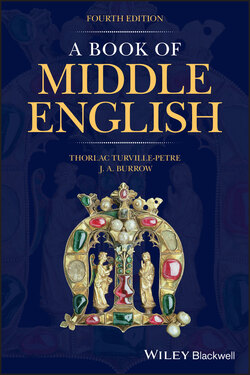Читать книгу A Book of Middle English - J. A. Burrow - Страница 39
4.3.6 The Definite Article
ОглавлениеThe definite article ‘the’ had in Old English no fewer than ten different forms depending on gender, case and number, but these distinctions could not survive the decay of the system of noun inflexions, with the result that there remained only the indeclinable form þe (or in some dialects te following ‐d/‐t, as in and te, at te). þe is the invariable form in all texts in this book except in two early works from the South and South‐West Midlands (texts 2 and 3). Forms there for the singular definite article are:
| masculine: | ||
| nom. | þe | (þe riche mon, 3/47) |
| acc. | þane, þene | (þene hul, ‘the hill’, 3/96) |
| gen. | þas | (þas monnes, 2/338) |
| dat. | þan, þon | (to þan hulle, ‘to the hill’, 3/87) |
| feminine: | ||
| nom./acc. | þo, þa, þæ | (þo ule, ‘the owl’, 2/26) |
| gen./dat. | þere, þare | (þare hule, ‘of the owl’, 2/28) |
The nominative and accusative neuter form is þat, still used as the definite article as well as the demonstrative: þat alre worste, ‘the worst of all’, 2/10.
Plural forms are:
| nom./acc. | þa | (þa Bruttes, 3/128) |
| dat. | þan | (to þan hulles, 3/94) |
In later texts there are occasional fossilized remains of an inflected form, as in the phrases after þan, ‘after that’, 5/597, and for þe nones, ‘indeed’, 5/53, 11/38, from the earlier for þan anes.
